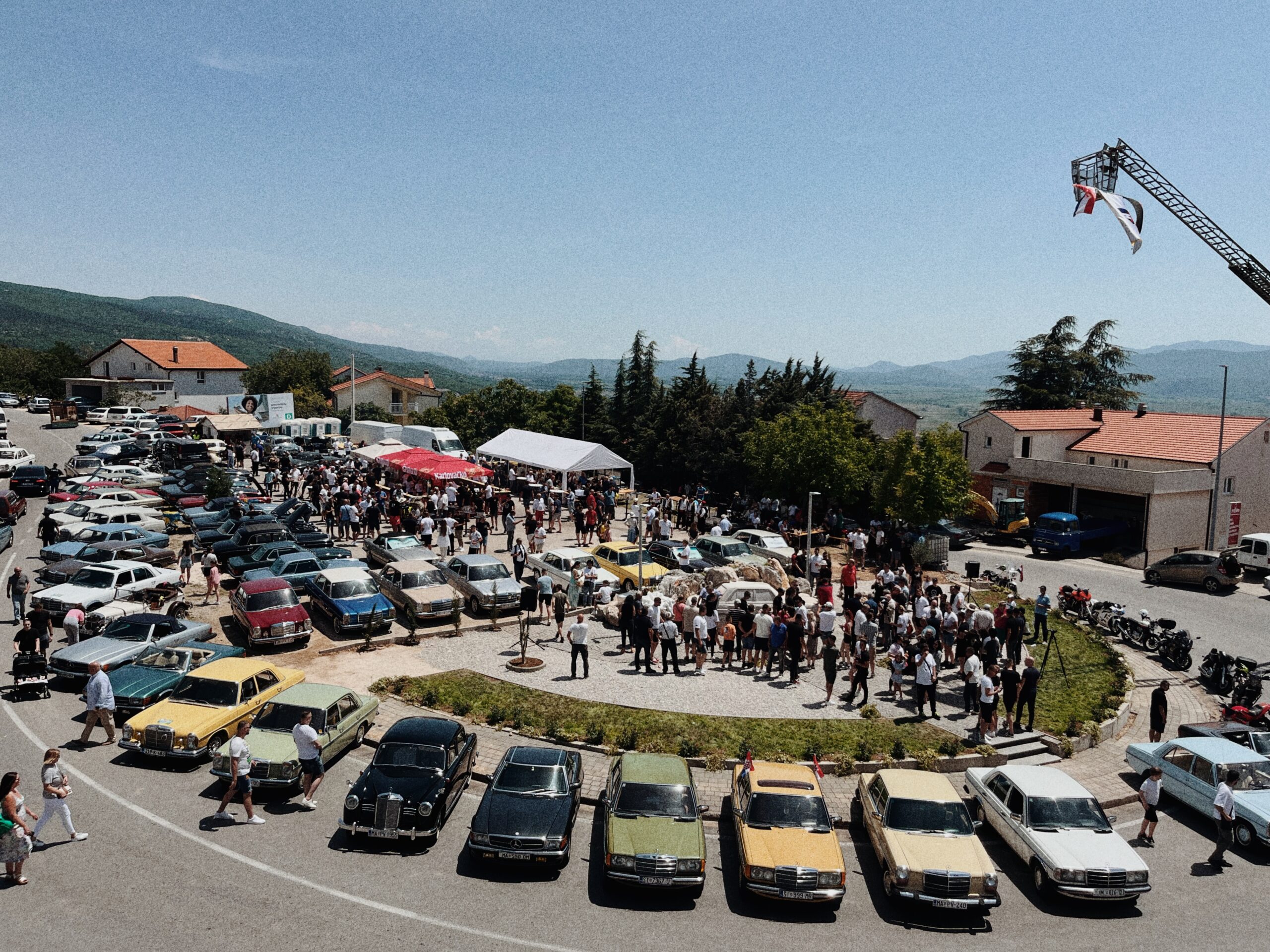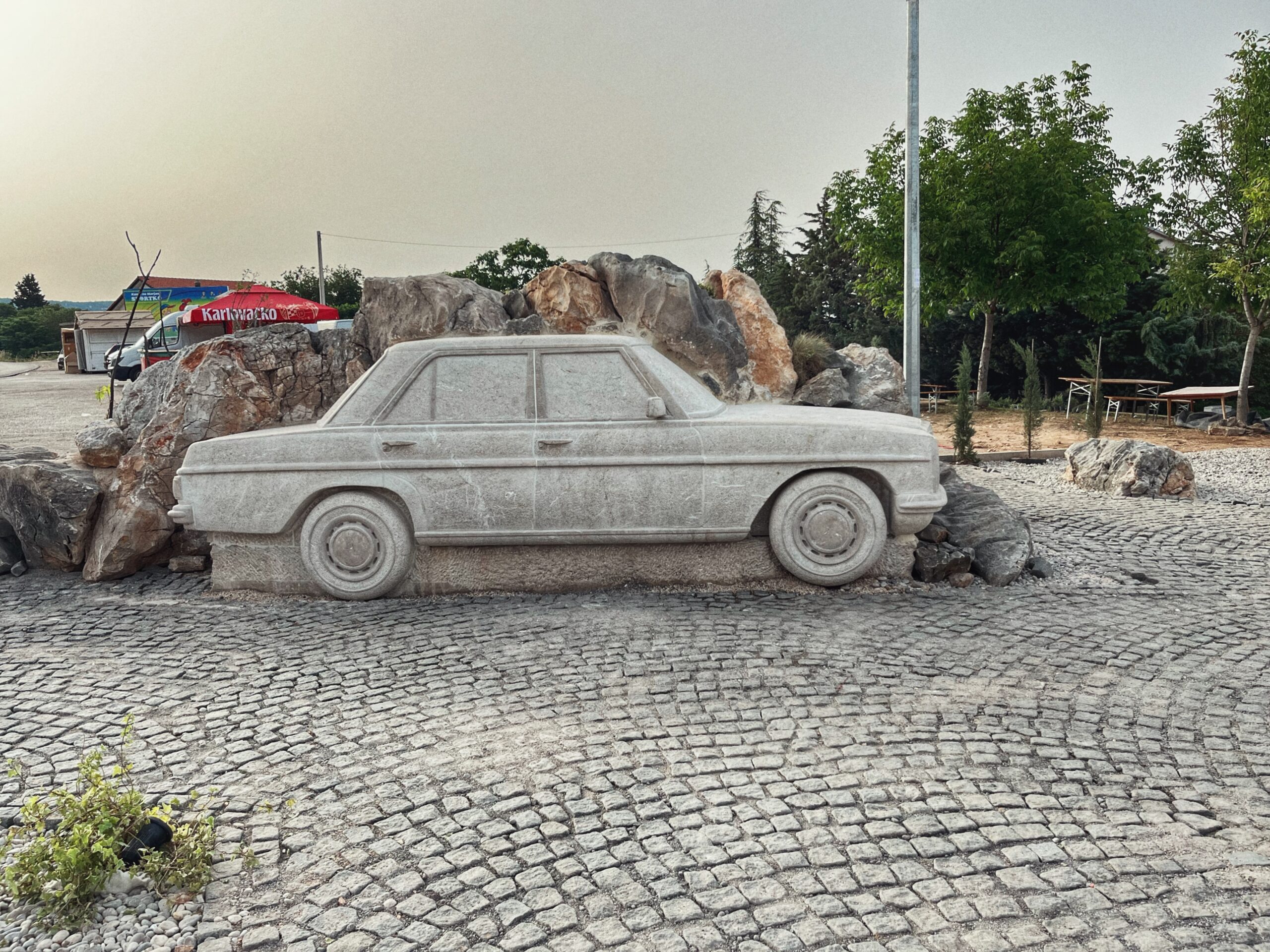Introduction
At the beginning of June, Croatian and German flags flew over Imotski, a town in southern Croatia, as citizens gathered for a two-day celebration. They celebrated the unveiling of the “Mercedes” monument, a life-size replica of the Mercedes 115, popularly known as “Minika”. This monument, idiosyncratic as it is, is also an excellent point of departure to understand how the local community commemorates its Gastarbeiter heritage, a significant chapter in the town’s history.
Imotski holds a unique place in Croatia. For decades now, jokes have been circulating in Croatia about the town’s deep attachment to Mercedes cars. What many initially perceived as humorous is much more than just a joke. The bond between the people of Imotski and Mercedes spans half a century. Its roots can be found in the mid-1960s when residents began migrating to Western Europe, particularly the Federal Republic of Germany, in search of a better life. Imotski became one of the most emigration-prone places in the former Yugoslavia. In 1971, the census recorded 18.5% of the municipality’s population as working abroad – the highest such value for the whole country, most of them in West Germany. West Germany, thus, came to play a pivotal role in the lives of these Gastarbeiter, nurturing generations of Imoćani and fostering a deep-seated gratitude that exists to this day. Therefore, it is no surprise that the German flag flew alongside the Croatian one during the recent celebration. Gratitude to Germany has been passed down through generations, with even those who have no direct connection to the country often holding it in high regard. This sentiment is captured in the popular rap song “Danke Deutschland” by local artist Ante Cash, who thanks Germany for “Mercedes and Deutsche Marks,” symbolising the profound impact Germany has had on the community. Indeed, if you spend some time in this small town, it is certain that you will feel the connection and gratitude of its inhabitants towards Germany.
Migration Stories and the Mercedes Connection
The return of Gastarbeiter to their hometowns in Mercedes cars became a powerful symbol of success. Customs regulations in Yugoslavia made it very difficult to import foreign cars, so owners of Mercedes and other popular foreign car brands stood out from the rest of the population. A Mercedes in the driveway was a tangible sign of a better life achieved abroad, contrasting strongly with the modest means with which many had left, and of those who had remained at home. This phenomenon led to the omnipresence of Mercedes cars in Imotski, earning the town the reputation of having the most Mercedes vehicles per capita in Croatia.
The idea of a Mercedes monument was first proposed five years ago by an organization of Mercedes enthusiasts. And for them, on that June morning when it was unveiled, the town transformed into the centre of the world, with the streets full of various models, from classic old-timers to the most modern. The high temperatures did little to deter the crowd of over a thousand people who eagerly waited for the monument’s official opening, while listening Croatian patriotic songs and enjoying local cuisine and many kinds of rakija.
But why Mercedes? The car symbolizes reliability and endurance, qualities the Gastarbeiter claim for themselves as well, and qualities often evoked in descriptions of the Imotska Krajina, where a tough environment taught people to become resilient. Furthermore, many people from Imotski migrated to the Stuttgart area, home to the Mercedes factories, where they became intimately familiar with these solid and durable vehicles. One of my interlocutors emphasized this connection during the monument’s unveiling, remembering how his family members went to Germany with the hope of improving their lives and returned not only with basic necessities but also a Mercedes car, a symbol of their hard-earned prosperity. When Imotski’s Gastarbeiter were returning to their hometown, they knew which car their community would expect them to be driving. Some even went as far as renting a Mercedes for the occasion. One local man mentioned, “Anyone who returned home with a Fiat was considered a failure by their family because Fiat vehicles were known to easily break down.”
The public’s acceptance of the monument underscores its significance. It resonates deeply with the local community, evoking shared memories and experiences that transcend mere aesthetics. This emotional connection was tangible during the unveiling, as attendees also reflected on the sacrifices of those who never returned to Imotski. People connect with this car brand not just for its beauty, but for everything that it represents: Imagine accompanying your father to the Imotski bus station, riding on a donkey as he leaves for a job in Germany, and then, years later, you see him returning in a luxurious Mercedes car. When a Gastarbeiter parked a Mercedes in front of his house, it signaled success gained abroad and a better life that he brought to his family. This encapsulates the migration story of Imotski.
I spent an entire day in Imotski during the monument’s unveiling and was struck by how vividly the region remembers its Gastarbeiter past. The monument’s location will soon be designated as the “Square of Imotski’s Emigrants” (Trg Imotskih iseljenika), complementing existing Street of Imotski’s Emigrants (Ulica Imotskih iseljenika). The Mercedes monument stands as a testament to the success of Imotski’s Gastarbeiter and will help in passing this narrative, and the community’s pride in it, down through generations.
Imotski is not the only town where a monument has been erected in memory and gratitude to local Gastarbeiter. In Herzegovina, whose cities also experience high rates of external migration, there are already two such monuments: one in Tomislavgrad and another in Prozor Rama, both depicting Gastarbeiter. The first, located near the bus station, and the second, near the bank, leave a profoundly somber impression, clearly illustrating a sad and difficult chapter in the history of these places. Here is where Imotski stands apart: not only is its monument not in the shape of a man, but of a car – the focus here is on pride.
According to the organisers, the Mercedes monument is to become the focal point for future anniversary ceremonies and commemorative practices. These events will revive and celebrate the childhood stories of fathers returning home in a Mercedes, keeping the memory of Imotski’s Gastarbeiter past alive. This active remembrance will resonate throughout the community and beyond. Moreover, the monument’s unveiling generated unprecedented media coverage about Imotski and its migration history, with stories appearing across Croatian media and social networks. This exposure has educated younger generations, who may not even know where Imotski is located, about the region’s migration history.
Conclusion
We must remember that this Mercedes monument is more than just a tribute to a car brand; it is a memorial to the emigrants of Imotski. Therefore I would like to conclude this essay with a quote from the main initiator of the monument, who, reflecting upon his grandfather, father, uncle, and all other Gastarbeiter from Imotski, stated at the opening: “Out of our gratitude to them, we chose to build the Mercedes 115 monument to thank them for their efforts in building this town and region. They built us; they educated all of us who succeeded.” The monument carves this legacy into stone.


